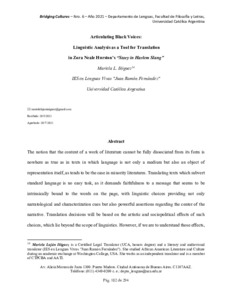Please use this identifier to cite or link to this item:
https://repositorio.uca.edu.ar/handle/123456789/18482| Título: | Articulating black voices: linguistic analysis as a tool for translation in zora neale hurston’s “story in harlem slang” | Autor: | Iñiguez, Mariela L. | Palabras clave: | Hurston, Zora Neale, 1891-1960; LINGÜISTICA; DIALECTOS; TRADUCCION; LECTURA INSTRUMENTAL | Fecha de publicación: | 2021 | Editorial: | Universidad Católica Argentina. Facultad de Filosofía y Letras. Departamento de Lenguas | Cita: | Iñiguez, M. L. Articulating black voices: linguistic analysis as a tool for translation in zora neale hurston’s “story in harlem slang” [en línea]. Bridging Cultures. 2021 (6). Disponible en: https://repositorio.uca.edu.ar/handle/123456789/18482 | Resumen: | Abstract:
The notion that the content of a work of literature cannot be fully dissociated from its form is
nowhere as true as in texts in which language is not only a medium but also an object of
representation itself, as tends to be the case in minority literatures. Translating texts which subvert
standard language is no easy task, as it demands faithfulness to a message that seems to be
intrinsically bound to the words on the page, with linguistic choices providing not only
narratological and characterization cues but also powerful assertions regarding the center of the
narrative. Translation decisions will be based on the artistic and sociopolitical effects of such
choices, which lie beyond the scope of linguistics. However, if we are to understand those effects, we must first look into the linguistic layer of the text. In this sense, sociolinguistics and descriptive
linguistics provide valuable tools for the type of reading that is necessary for translation, both by
allowing us to identify the dialect in question and by providing a reliable framework to establish
the reasons behind characters and narrators' use of language, all of which will need to be considered
when writing in the target language. In this paper, I explore these concepts by looking at African
American Vernacular English and illustrate the proposed instrumental reading by analyzing how
Zora Neale Hurston constructs black voices and positions a black narrative center in Story in
Harlem Slang. Resumen: La idea de que el contenido de una obra literaria nunca puede separarse del todo de su forma adquiere especial relevancia en los textos en los que la lengua no es solo un medio sino también el objeto mismo de la representación, como a menudo ocurre en las literaturas de minorías. Traducir textos que se alejan de la lengua estándar supone un verdadero desafío: el mensaje está íntimamente ligado a la forma, que proporciona claves de lectura en torno a la narración, la caracterización de los personajes y el centro del relato. A la hora de tomar decisiones, los traductores tienen en cuenta los efectos artísticos y sociopolíticos de estas opciones léxicas, gramaticales y fonológicas, cuestiones que escapan a la lingüística. Sin embargo, para comprender estos efectos, primero hay que detenernos en los aspectos lingüísticos. En este sentido, la lingüística descriptiva y la sociolingüística se vuelven grandes aliadas de la traducción, ya que no solo permiten identificar el dialecto en cuestión sino que, además, ofrecen un marco de referencia sólido para analizar las elecciones lingüísticas de los personajes y narradores, lo que será de vital importancia a la hora de redactar el texto en la lengua meta. En este trabajo, me valgo del inglés afroestadounidense para analizar estos conceptos e ilustro el tipo de lectura instrumental propuesta al analizar la construcción de voces afroestadounidenses y de un centro narrativo afroestadounidense en Story in Harlem Slang de Zora Neale Hurston. |
URI: | https://repositorio.uca.edu.ar/handle/123456789/18482 | ISSN: | 2525-1791 | Disciplina: | LENGUA | Derechos: | Atribución-NoComercial-CompartirIgual 4.0 Internacional | Fuente: | Bridging Cultures. 2021 (6). |
| Appears in Collections: | BC - 2021 nro. 06 |
Files in This Item:
| File | Description | Size | Format | |
|---|---|---|---|---|
| Articulating_Black_Voices.pdf | 686,87 kB | Adobe PDF |  View/Open |
This item is licensed under a Creative Commons License

